The Pros and Cons of 7 Classic Scanner Models
 You’ve taken the plunge and decided to invest in an inventory management system, and you need a high quality scanner that fits your needs. You’ve done all the research on computer systems, warehouse space, and financing, and now you are faced with the seemingly trivial but critical decision—which barcode scanner system to purchase for the business?
You’ve taken the plunge and decided to invest in an inventory management system, and you need a high quality scanner that fits your needs. You’ve done all the research on computer systems, warehouse space, and financing, and now you are faced with the seemingly trivial but critical decision—which barcode scanner system to purchase for the business?
We see a lot of scanners come through the shop, and not all of them are created equal. While there are new apps for phones and iPads for scanning using the device’s camera, we’re focusing our comparison on the classic scanners we see work best—the ones that are rugged, tough, and built for the day-in, day-out grind.
Barcode scanners may seem all the same, but very few devices have such a big impact in terms of determining whether your employees’ tasks are simple and organized or turn out to be complex and hectic. While it seems like any scanner would do for your business, a deeper dive into the pros and cons of some of the top models will help you make an informed decision. Before we dive into a comparison of seven of our favorite models, let’s take a look at the most important questions to answer before jumping into the purchasing process.
11 Essential Questions to Answer Before Purchasing a Barcode Scanner
There are at least 11 essential questions you need to think about before jumping into a scanner purchase. To get the best use out of your equipment and use it to its fullest potential, it helps to know how, when, and where you’ll be using the equipment. A few of the most common questions you should be able to answer include:
- Do I need a corded or Bluetooth model?
- What technology and barcode system compatibility do I need?
- How close or far does my scanning distance require?
- How ergonomic and lightweight does it need to be?
- What are my temperature requirements and external environmental conditions?
- What connectivity capabilities do I need?
- How many scanners will I need?
- How durable and long-lasting will the scanner be?
- How long will the battery life be?
- What is my price budget?
- Is new, used, or renting the best option for my business?
Depending on your answers to the questions above, the model of scanner you choose might be different. Below we’ve outlined the pros and cons of seven popular scanner models that we sell and repair on a regular basis. Some of these scanners are available in brand new condition, and others are no longer brand new through retail outlets but can be purchased used or refurbished from Bar Code Depot.
Honeywell Scanners
Honeywell has been around for more than 100 years, so it’s no surprised that they’ve got some great models and a reputation to go with it. They’re a Fortune 100 company for good reason. Two of the models that we regularly see and handle are the Honeywell 1980 series and the Honeywell MX7.
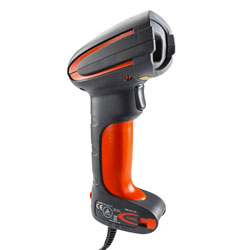 Honeywell 1980 and 1980i Scanner
Honeywell 1980 and 1980i Scanner
Pros of the Honeywell 1980 and 1980i
One of the most popular classic models is the 1980 series. In terms of the positives, these scanners are a single scanning solution. Lightweight at 11.8 oz., they are an industrial grade scanner and provide a cable option. They offer omni-directional scanning up to 52ft away, and they read both 1D & D2 barcodes. They also offer an integrated laser pointer, which helps when aiming the scanner at barcodes high up or far away. They have a strong IP 65, so they keep dust out, and they are water resistant. However, you wouldn’t want to submerge this in a bucket of water. The 1980 series also has a strong durability rating. They can withstand up to 5,000 tumbles from a 3ft. distance, and they can withstand 50 drops from about 6ft. Depending on whether you purchase new or used, the new versions offer a 3-year factory warranty. Finally, this scanner was built to work in extreme temperatures. It operates in temperatures ranging from -22°F to 122°F.
Cons of the Honeywell 1980 and 1980i
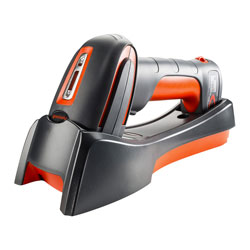 In terms of the downsides, this scanner is not for those looking for a wireless solution. It requires a cable. For those wanting a similar model that is wireless, the Honeywell 1981i may be worth investigating. The other downside of the 1980 series is that they are moderately expensive, especially for a new one. They typically retail in the $600-$1,500 range for a single, new device but can also be found online for $400-$600 for refurbished and used models. So if you’re looking for a good overall scanner and you are able to tolerate a cable situation, this one may be for you. You also get the Honeywell name brand to give you confidence in the quality.
In terms of the downsides, this scanner is not for those looking for a wireless solution. It requires a cable. For those wanting a similar model that is wireless, the Honeywell 1981i may be worth investigating. The other downside of the 1980 series is that they are moderately expensive, especially for a new one. They typically retail in the $600-$1,500 range for a single, new device but can also be found online for $400-$600 for refurbished and used models. So if you’re looking for a good overall scanner and you are able to tolerate a cable situation, this one may be for you. You also get the Honeywell name brand to give you confidence in the quality.
 Honeywell MX7 Scanner
Honeywell MX7 Scanner
Pros of the Honeywell MX7
Another Honeywell model that makes our list is the MX7. This is a top-of-the-line barcode scanner with all the bells and whistles. It has voice command options and an ergonomic, easy-grip handle. It operates on a Windows OS and offers ample storage in both ram (128MB) and flash memory (up to 1GB). It comes with keypad options of both 55 and 32 keys. This model has an LED backlight for hard-to-read lighting conditions and a 3.5” VGA TFT color display. It also has a resistive touch screen and stylus pen. It weighs about average at 21oz.
In terms of performance, it has a good 40 ft. scanning range, and it can also scan objects as close as 4 inches. It also is offers a cordless option through the use of 802.11b/g radio & Bluetooth connectivity. This allows more freedom and movement when scanning in the field or warehouse. This model offers USB and RS-232 interfaces for additional connections. It also has a useful scan vibration signal to confirm input. The MX7 uses a standard rechargeable lithium-ion battery and can operate in a range of temperatures, operating from 14°F to 122°F.
Cons of the Honeywell MX7
In terms of the cons, this model is not quite as rugged as some of the other models. The 14°F cold rating is not as cold tolerant as several of the other models that operate effectively at sub-zero temperatures. If you’re in Florida or Georgia, you may be fine, but in Minnesota or Alaska, not so much – especially if you’re working outside. And while the manufacturer touts the MX7’s ability to endure drops of 5 ft. and 6 ft., they don’t specify the frequency of drops and tumbles it can withstand like some of the other manufacturers do. The other downside of this model is that it is one of the most expensive models available. All this connectivity and impressive functionality comes at a cost. The MX7 frequently retails new at 1,500-$3,000 or $500-$1,000 refurbished or used.
So if you’re looking for a wireless scanner with strong connectivity options that isn’t going to be used in extreme conditions and you have a generous budget, this one may be the right choice for you.
Intermec Scanners
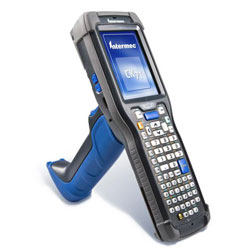 Intermec CK71 Scanner
Intermec CK71 Scanner
Intermec was founded in 1966 and was subsequently acquired by Honeywell in 2012-2013. One of the Intermec’s models that offers incredible versatility is the Intermec CK71.
Pros of the Intermec CK71
One of the main benefits of the CK71 is that it offers advanced features and extreme performance. It is a handheld cordless barcode scanner and has WiFi and Bluetooth connectivity. It can scan both 1D and 2D barcodes from about 6 inches up to 50 ft., which is one of the longest distance ranges in its class. It’s loaded with other features as well. It uses Windows OS and boasts an impressive storage capacity, with 512mb of Ram and up to 1GB ROM memory. It has a 3.5” TFT display with an LED backlight. It comes in optional 43 and 59-key numeric keypads, as well as a QWERTY keypad option. The CK71 can operate from -4°F to 140°F, which is one of the hottest temperature ranges in any of the scanners we see. It is also durable. It can withstand up to 26 drops of 6ft and up to 2,000 drops of 3ft. It weighs 19.75 oz. and uses a typical 3.7V rechargeable lithium ion battery. It also uses the Texas Instrument (TI) OMAP 3530 processor, which is considered one of the best in class processor for imaging, graphics, and video applications.
The CK71 manufacturer prides itself in that this scanner is easily updated, which they claim lowers the cost of ownership. Some other nifty features include a 5-megapixel autofocus camera, which also can convert images to PDFs, so you can take pictures in the field and organize documents by converting them into the universally used PDF format. The CK71 also offers the SmartSystem that reports on the health of the device.
Cons of the Intermec CK71
In terms of the cons, the main issue is that it is on the high end of the price spectrum. For all of the features mentioned, it costs in the $2,000-$3,000 new or $300-$1,000 for refurbished or used models, with most used models selling in the $600 range.
So if you want the top-of-the-line powerhouse cordless scanner that can be used in hot temperatures and have money to spend, this scanner may be your best bet.
Motorola Scanners
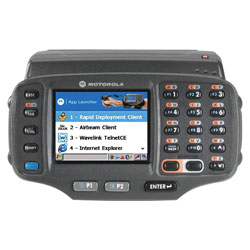 Motorola WT4090 Wearable Scanner
Motorola WT4090 Wearable Scanner
Motorola is another highly reputable company, having been around 90+ years, including 30 years in the barcode scanning market. There are several models to consider, and one we see customers enjoy is the WT 4090 wearable model.
Pros of the Motorola WT4090 Wearable
This barcode scanner has the advantage of a hands-free design, and the main scanner keypad can strap to your wrist or hip, which keeps your hands free for other tasks. More importantly, having the ability to strap this scanner to your wrist is ideal for long working hours where your employees’ wrists may get tired holding a heavy scanning gun. It’s not completely hands free in that you still operate the scanning device or ring with your hand or finger, while the bulkier keypad is strapped to your arm or hip. But this scanning device is extremely lightweight and would be usable for hours. In other words, your occupational therapist might appreciate the way this scanner’s design saves your hand muscles from repetitive cramping or holding a heavy object for hours on end.
This model has other features that make it appealing. It offers strong connectivity through WiFi and Bluetooth, and thus, it is cordless and can be mobile and move around a plant or warehouse. It is moderately hardy in terms of temperature range, operating from -4°F to 122°F. It also offers voice and text controls and a combination of both. It has right and left hand scanning options. The manufacturer also promotes its ability to recognize poorly printed labels. It has a 2.8” color and backlit display and is lightweight at 11.3 oz. It utilizes a standard lithium ion battery and operates with a Microsoft OS.
Cons of the Motorola WT4090 Wearable
In terms of the downsides, it is not as rugged or durable as several of the other models. The 102-page user guide specifies that this model can with stand “multiple” drops to concrete, including approximately 500-1000 drops of 1.6 ft. This is significantly less durable than other scanners, but since it’s strapped to your arm, this may or may not be a major factor for your situation. It’s scanning distance, according to the user guide, is optimal or guaranteed at approximately 7-54 inches, which about .5 ft. to just shy of 5 ft. It says it can go up to about 84 inches, or about 7 ft. But this model is not as competitive as other models that offer 40-60 ft. scanning. Given the mobile options and “wearability,” it is a bit pricey for what you get functionally. The WT4090 and the WT4000 series in general retail for around $2,000 new or can be found as cheap as $500-1,000 used online, although the condition of used items will obviously vary.
So for situations where you need more hands-free applications that won’t tire out your wrist and can scan relatively close and in moderate temperatures, this could be a good option. If you have extreme conditions or think it will be dropped more often, it’s best to look elsewhere.
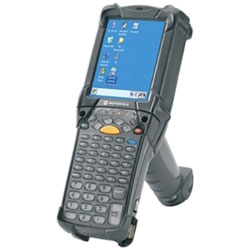 Motorola MC9090 Scanner
Motorola MC9090 Scanner
Pros of the Motorola MC9090
Another option for those who like the Motorola brand is the MC9090. It is a more traditional scanner gun with a pistol grip and offers some enhanced features when compared to the Motorola WT 4000 series and WT4090 wearable. The MC9090 offers voice and data connections. It is cordless and offers multiple wireless connectivity options that include WiFi, Bluetooth, and Pan. It houses a FRID reader and provides an alpha and numeric keypad. It has a 3.8” TFT display and an impressive 15.8 watt-hour battery life to cover most full-day shifts. Like other scanners, it uses rechargeable lithium ion batteries. It has a strong scanning range of up to 40 ft. and can also scan as close as 4 inches. It operates in extreme conditions from -4°F to 122°F and can withstand 2,000 stumbles of 3ft. This Motorola is more robust and durable when compared to the wearable WT 4000 series.
Cons of the Motorola MC9090
In terms of the cons, it’s just kind of middle-of-the road. In other words, there’s nothing special that really stands out with this model. It has 64MB Ram and 128 MB Flash, which may be good enough for some applications, but not as impressive as other scanner storage capabilities. It’s tumble rating is below several of the other scanners. And these mid-range features are reflective in the mid-range pricing, which typically sells in the $500-$1,000 range refurbished.
So if you feel prefer the Motorola brand and want a traditional scanner gun that has a cordless option for normal working conditions with connectivity but won’t break the bank, this one may be for you.
Zebra Scanners
One final company that offers strong performance is the Zebra brand. Founded in 1969, this company has 35+ years of barcode scanning market. Zebra offers several models of barcode scanners useful for business applications.
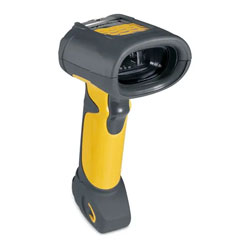 Zebra Symbol LS3408 Scanner
Zebra Symbol LS3408 Scanner
Pros of the Zebra Symbol LS3408
To begin, the LS 3408 model offers strong functionality and durability for businesses that are able to use a corded option. This scanner offers many of the similar features of other scanners, but it is particularly rugged and tough. It has one of the toughest ratings, being able to withstand up to 50 drops (from 6.5 ft) and up to 2,500 tumbles (from 3 ft.). It has an IP 65 sealing rating that protects it from dust and water. Again, this means it is dust resistant and water resistant. It offers a bright 650 nm laser aim dot for scanning and a dual scan angle for increased accuracy. It is also highly functional in its scanning distance, ranging from .25” to 45 ft., which is the best macro (close-up) scanning range option on our list.
While the LS 3408 is a corded scanner, it makes up for this fact by providing multiple onboard and universal interfaces, including RS232, USB, Keyboard Wedge, IBM 468X/469X, Scanner Emulation, Synapse. It is relatively lightweight at 12.56 oz. It also has one of the widest total temperature ranges, operating from -22°F to 122°F, and the company offers a 3-year workmanship and materials warranty for new products. So depending on where you purchase this one, you may want to ask whether a warranty is still possible.
Cons of the Zebra Symbol LS3408
In terms of the cons, the main downside is that it is not a cordless option. This creates some limitations for certain businesses. The price for all these features tends to be in the $500-$700 range refurbished, which is a terrific value for this type of functionality. It also does not have some of the advanced imaging of some other scanners.
So if you can deal with the limitation of a corded option, this model packs a punch and has incredible value for the price.
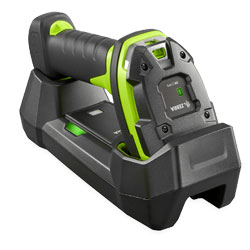 Zebra DS3600 Series Scanner
Zebra DS3600 Series Scanner
Pros of the Zebra DS3600
The final Zebra model that bears mentioning is the DS3600 series, which is a true workhorse. There are multiple different models within this series, and it comes in corded and cordless models. Depending on the model, the 3600 series offers 1D, 2D, OCR, and IUID scanning capabilities. Like the Zebra Symbol LS3408, it has a strong scanning capabilities, from about 2 inches to 56 ft., one of the longest ranges in its class. It also is one of the most durable scanners on the market, being able to withstand 8ft. drops and up to 5,000 tumbles of 3 ft. It has an IP 67 rating, which is not only dust proof, but is waterproof as well. Other models at the IP 65 rating are water resistant only. The IP rating means it can be submerged in more than 3ft. of water for about half an hour before it will do any damage. The 3600 series offers some of the top of the line temperature options, and its corded options operate from -4°F to 122°F, while its cordless models operate during an impressive -22°F to 122°F range, one of the coldest ratings in its class.
The DS 3600 series also has very strong battery life. This scanner uses a 3100 mAh rechargeable lithium ion battery, which the manufacturer manual says can run for 100,000 scans per battery charge—more than twice the amount of other models in its class. It also captures difficult-to-read bar codes. These scanners offer several wireless connectivity options, including Bluetooth, radio, and WiFi capabilities. For the corded models, it supports standard interfaces such as: USB, RS232, Keyboard Wedge, Industrial Ethernet, EtherNet/IP, Profinet, Modbus TCP and TCP/IP. These scanners are relatively lightweight at 11-15 oz.
A few other nifty features include multiple feedback modes for scanning, including vibration and red and green LED lights. It has an intelligent document capture system can take photos and is compatible with other Zebra 3600 series models for integration.
Cons of the Zebra DS3600
Depending on the scanner, some models are limited in terms of what type of scanning they can do (1D, 2D, etc.). So it makes sense to do more in-depth research or ask a professional technician which of the 3600 models is best for your situation. These models also don’t seem to be able to convert the images to PDFs as easily as some other image scanners. Depending on the model, some are corded while others are cordless, so do your research on which model offers each function. In terms of pricing, they range from $500-$1,700 new or somewhere in the ballpark of $300-$500 refurbished or used. So the price is moderate overall and provides exceptional value for the functionality you get in return.
So if you’re looking for a workhorse barcode scanner with a battery life of 100,000 scans and has almost all the features you could want, this scanner offers probably the best value and functionality combined of any on this list.
Conclusion & Recommendations
Depending on how, when, and where you’re going to use the scanners, these seven scanners offer different features and have unique limitations. Before you go purchase one or more of these, take the time to answer the 11 essential questions, read more online, or schedule a time to talk to a professional technician to see which one is best for you and your business.
